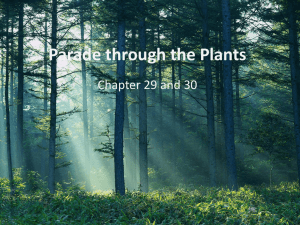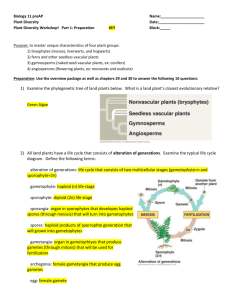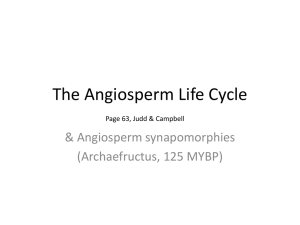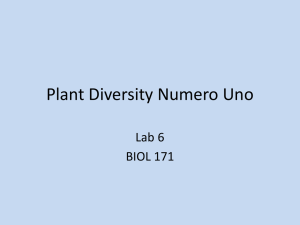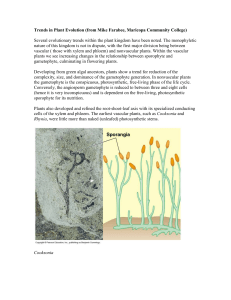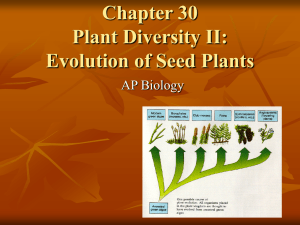The plant kingdom is in the domain Eukarya and in
advertisement
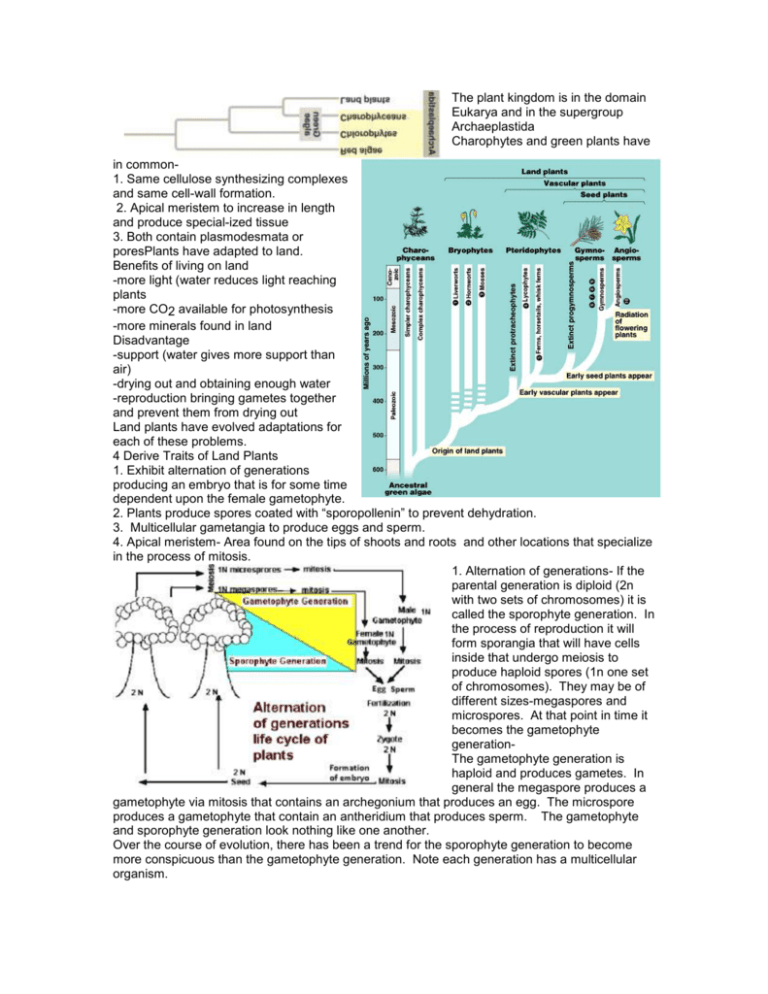
The plant kingdom is in the domain Eukarya and in the supergroup Archaeplastida Charophytes and green plants have in common1. Same cellulose synthesizing complexes and same cell-wall formation. 2. Apical meristem to increase in length and produce special-ized tissue 3. Both contain plasmodesmata or poresPlants have adapted to land. Benefits of living on land -more light (water reduces light reaching plants -more CO2 available for photosynthesis -more minerals found in land Disadvantage -support (water gives more support than air) -drying out and obtaining enough water -reproduction bringing gametes together and prevent them from drying out Land plants have evolved adaptations for each of these problems. 4 Derive Traits of Land Plants 1. Exhibit alternation of generations producing an embryo that is for some time dependent upon the female gametophyte. 2. Plants produce spores coated with “sporopollenin” to prevent dehydration. 3. Multicellular gametangia to produce eggs and sperm. 4. Apical meristem- Area found on the tips of shoots and roots and other locations that specialize in the process of mitosis. 1. Alternation of generations- If the parental generation is diploid (2n with two sets of chromosomes) it is called the sporophyte generation. In the process of reproduction it will form sporangia that will have cells inside that undergo meiosis to produce haploid spores (1n one set of chromosomes). They may be of different sizes-megaspores and microspores. At that point in time it becomes the gametophyte generationThe gametophyte generation is haploid and produces gametes. In general the megaspore produces a gametophyte via mitosis that contains an archegonium that produces an egg. The microspore produces a gametophyte that contain an antheridium that produces sperm. The gametophyte and sporophyte generation look nothing like one another. Over the course of evolution, there has been a trend for the sporophyte generation to become more conspicuous than the gametophyte generation. Note each generation has a multicellular organism. 2. Plants produce spores coated with “sporopollenin” to prevent dehydration in multicellular compartments. Green algae produce their spores in just one cell. 3. Multicellular gametangia to produce eggs and sperm. 4. Apical meristem- Area found on the tips of shoots and roots and other locations that specialize in the process of mitosis. In the course of evolution of land plants, major events occurred to include development of vascular tissue, stems, leaves, roots, seeds and flowers. There are major groupings include bryophytes, seedless vascular plants and the plants that produce seeds and flowers. I. Bryophytes are nonvascular land plants. They do have structures that resemble leaves and roots(rhizoids) but these tissues have no vascular tissue. There are three bryophyte phyla but they do not form a monophyletic clade. The gametophyte generation is the most conspicuous. A. Liverworts(Phylum Hepatophyta)-flatten body (thallus) with lobed like shape. Form cup like structure for reproduction. The gametophyte generation is the most conspicuous generation. B. Hornworts (Phylum Anthocerophyta)-The gametophyte is leafy, and the sporophyte generation grows out of the gametophyte generation and is dependent on it. C. Mosses(Phylum Bryophyta)- are bryophytes over 15,000 species. Usually found in moist area. Has leaf-like structures and rhizoids. The archegonia and antheridia are found at the top of the gametophyte. Once fertilized the sporophyte grows out of the top of the gametophyte forming a capsule where meiosis and spores are formed. forming a capsule where meiosis and spores are formed. Phylum Lycophyta-Evolution of vascular tissue. Two types of tissue evolvedXylem-moves water and minerals up and is strengthened with lignin in cell walls Phloem moves water and organic nutrients both up and down. Also leaves (microphylls only one strand of vascular tissue) and roots evolved as extensions from the stem. Sporophyte generation conspicuous generation. Microphylls contain sporangia at the top of the plant in a strobli. Three major classes include club mosses, spike mosses and quillworts. Club moss with vascular tissue. Microphylls containing sporangia at the top of the plant. Club moss with vascular tissue. Microphylls containing sporangia at the top of the plant Phylum Pterophyta-Includes ferns, horstails and whisk ferns The evolution of megaphylls or true leaves with branched vascular bundles in the leaf. Allows for increased photosynthesis. Ferns have underground horizontal stem (rhizome) and leaves (frond) that push up from the soil. The gametophyte generation reduced. The Phylum Pteriodophyta includes horsetails and whisk ferns. Horsetails-only one genus. Underground rhizome, that produces aerial stems with whorls of side branches. Silica found in cell walls. Whisk ferns-lack megaphylls and roots. Only branching stems and root. Seed plantsproduce seeds in the sporophyte generation. A seed consist of a seed coat, food, and sporophyte embryo. Also spores produced by the sporophyte generation are retained in the plant and are not released into the environment. All seed plants produce two different types of spores (heterospory). Microspores make the male gametophyte (pollen) and megaspores make the female gametophyte inside a structure called the ovule. The female gametophyte never leaves the sporophyte. The ovule eventually becomes the seed once the egg of the female gametophyte is fertilized. Note-sperm cells are not released into the environment like seedless plants. The entire male gametophyte is used to deliver the sperm cells. Seeds and pollen eliminates the necessity of water for reproduction. Both can be carried long distances and have a thick coats to resist drying out. Two major types of seed plants-Gymnosperms and angiosperms. Gymnosperms produce naked seeds (ovule not complete enclosed in sporophyte tissue). Does not produce fruit or flowers like angiosperms. Gymnosperms Conifers-Large gymnosperm group 575 species most do not shed their leaves in the fall. Includes pine tree, junipers and sequoias. It takes 2 yrs to produce a seed. Phylum Cycadophyta-cycads have large cones and palmlike leaves. Phylum Ginkgophyta-only one species surviving. Diciduous fan leaves with fleshy seeds. Phylum Gnetophyta-species are found in tropics and desert and varies greatly in morphology. Phylum Anthophyta-Flowering plants Characteristics-flowers and the production of seeds. Most successful plant phylum. A flower is a structure specialized for reproduction. 1. Sepal-leaf like and protects the floral bud. 2. Petals-Usually showy with colors to attract pollinators 3. Stamen-male reproductive organ. Contains an anther where male gametophytes or pollen is produced. The anther sits long stalk called the filament, which connects to the base of flower 4. Carpel-female reproductive organ. The swollen bottom or ovary contains one or more ovules where the female gametophyte is found. The ovary connects to a slender structure called the style. At the top of style is the stigma where the pollen lands. A flower may have multiple carples or only one.A flower can have both male and female reproductive organs. If it does, it is termed perfect but if it does not it is termed imperfect. Male flowers are called staminate flowers and female flowers are called carpellate flowers. If both flowers are on the same plant, then the plant is said to be monoecious but if they are on different plants (male date palms vs. female date palms), then the plant is dioecious. Corn is a monoecious plant with stamenate and carpellate flowers on the same plant. Sagittaria is dioecious. The plant on left is male and the right female. Microgametogenesis-In the anther chambers there are microspore mother cells (2n). They undergo meiosis to produce 4 microspores (n). The microspores undergoes mitosis to produce a spore with two nuclei, one becomes the tube cell and the other the generative cell. The generative cell will undergo mitosis once more to make two sperm nuclei. This is the male gametophyte. The male gametophyte will form a very drought resistant pollen grain. The shape is species specific. Megagametogenesis-Is the formation of the female gametophyte. Inside the ovary, there is one or more ovules. Each ovule has a megaspore mother cell (2n). This cell will undergo meiosis to produce 4 megaspores (n). Three of cells will degenerate but one will survive to give rise to female gametophyte. The megaspore (n) will under-go three mitotic divisions without cytokinesis to give rise to eight nuclei. Division of the cytoplasm will then occur. It will produce seven cells. Three on each end and one in the middle. Pollination and fertilizationOnce a pollen falls on the stigma of the carpel, the pollen begins to digest the neck of the style and sending down a pollen tube. This pollen tube will have the tube nucleus in it. It will be followed by the generative nucleus which will undergo mitosis to form 2 sperm nuclei. The pollen tube is making its way to ovule which is housing the female gametophyte. There is an opening in the ovule called the micropylle. The pollen tube sends one sperm nucleus to fertilize the egg, and the second to fertilize the polar nuclei or large central cell. This cell becomes triploid (3n) and is called endosperm. This is a case of double fertilization. The fertilized egg or zygote will give rise to the seed embyro, the endosperm will provide nutrients to the embryo. The ovule will become the seed coat. The ovary under the influence of hormomes will become the fruit of the plant. The fruit or pericarp of the plant is used to protect enclosed seeds and aids in their dispersal. . The two groups of flowering plants are the monocots and eudicots (formerly dicots)

